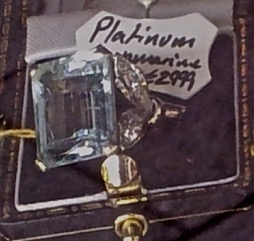I'm making an engagement ring which is a bit out of my comfort
zone.
I'm having trouble working out how to go about soldering two 6 x 4
mm marquise settings either side of a huge emerald cut aquamarine.
I'm using 18ct yellow gold settings. I wondered about binding wire
but that seemed too clumsy.
This sort of assembly is generally soldered in plaster.
You set up the settings on a soft base. I was taught to use
plasticine, but some people prefer sticky wax.
You arrange the settings into position, being careful to press them
into the base material deeply enough so that the points of contact
where they will be soldered are covered, but leaving the prongs
exposed.
You then make a wall around the set up, so that the assembly is
sitting in a little well. You pour plaster of paris into this well,
covering the assembly, and allow it to harden.
After the plaster has hardened you carefully remove it from the base
and the settings should come away from the support material with the
prongs embedded in the plaster and the girdle and bezel wires
exposed. You’ll be soldering from the back, with the assembled
settings upside-down in the plaster.
You must remove any and all of the base material from between the
settings or it will burn and interfere with the solder. Broken saw
blades are good for prizing the little bits of clay or wax from
between the settings. Also, before the plaster has completely cured
you can trim it with a bench knife so there’s not too much excess
around the set up that might impede the approach of the torch.
Let the plaster dry a good couple of hours before soldering, you
don’t want any residual moisture in the plaster when you heat it.
With the settings firmly set in the plaster you can solder them
together without fear of them moving under the torch. Once all the
joints are soldered and while the plaster is still hot you can quench
it in water and most of the plaster will crumble away.
With gold you are now ready to attach the gallery and shank. If,
however, you use this for a set up in platinum there’s a further
step.
Soldering platinum in plaster makes for very brittle joints. They
will snap easily. With platinum, after soldering you need to set the
clean assembly into a non-reactive high-temperature base and simply
remelt the solder in place. This will remove the brittleness imparted
by the plaster and make the joints strong. In the old days we used
powdered asbestos for this step.
Elliot Nesterman
ajoure.net
